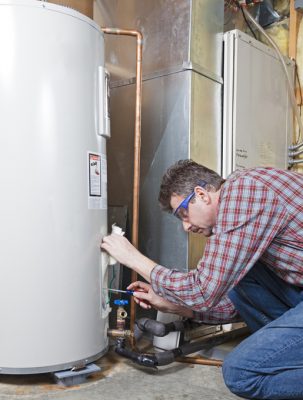Easy Ways to Maintain Your Home's Hot Water System Effectively
Easy Ways to Maintain Your Home's Hot Water System Effectively
Blog Article
We've found this post pertaining to What Kind of Maintenance Do Water Heaters Need? down the page on the net and felt it made good sense to discuss it with you here.

Warm water is vital for daily convenience, whether it's for a revitalizing shower or cleaning meals. To ensure your warm water system runs effectively and lasts longer, normal maintenance is key. This short article provides functional suggestions and insights on just how to preserve your home's hot water system to avoid disruptions and pricey repair services.
Introduction
Maintaining your home's hot water system may seem overwhelming, but with a couple of straightforward steps, you can guarantee it operates efficiently for many years ahead. This guide covers everything from comprehending your hot water system to do it yourself maintenance tips and recognizing when to call specialist help.
Relevance of Preserving Your Hot Water System
Normal upkeep not only expands the lifespan of your warm water system but likewise ensures it runs efficiently. Disregarding maintenance can cause decreased effectiveness, greater energy costs, and even premature failing of the system.
Signs Your Hot Water System Demands Maintenance
Understanding when your warm water system needs interest can protect against major problems. Keep an eye out for indications such as irregular water temperature level, strange noises from the heating system, or corroded water.
Understanding Your Hot Water System
Prior to diving into maintenance tasks, it's handy to understand the fundamental elements of your hot water system. Usually, this consists of the hot water heater itself, pipelines, anode rods, and temperature controls.
Regular Monthly Maintenance Tasks
Normal monthly checks can help catch minor problems prior to they rise.
Purging the Water Heater
Flushing your water heater eliminates debris build-up, boosting performance and prolonging its life.
Checking and Replacing Anode Rods
Anode rods avoid rust inside the storage tank. Evaluating and changing them when worn out is essential.
Examining and Changing Temperature Settings
Adjusting the temperature level setups guarantees ideal performance and safety.
DIY Tips for Upkeep
You can execute numerous upkeep tasks on your own to maintain your warm water system in top condition.
Checking for Leakages
Regularly evaluate pipelines and connections for leakages, as these can bring about water damages and higher expenses.
Testing Pressure Relief Valves
Examining the stress relief valve ensures it functions appropriately and stops too much stress buildup.
Shielding Pipelines
Protecting hot water pipes reduces warm loss and can save energy.
When to Call a Professional
While do it yourself upkeep is valuable, some problems need expert know-how.
Complicated Problems Needing Professional Help
Instances consist of major leaks, electric troubles, or if your hot water heater is constantly underperforming.
Routine Professional Upkeep Conveniences
Specialist maintenance can include thorough examinations, tune-ups, and making sure compliance with safety criteria.
Final thought
Regular maintenance of your home's warm water system is necessary for effectiveness, durability, and price savings. By following these tips and knowing when to look for expert assistance, you can ensure a dependable supply of warm water without unforeseen disturbances.
Water Heater Maintenance Tips
Test the TPR Valve
Shut off the power and the cold-water supply valve. Place a bucket under the pipe connected to the temperature-pressure-release (TPR) valve on the top or side of the tank. (This valve opens if the tank pressure gets too high.) Lift the valve’s tab to let some water out, then let go. If water keeps flowing, drain the tank partway, unscrew the old valve with a pipe wrench, and install a new one. Check the Anode Rod
Put a hose to the tank’s drain cock and let out a few gallons of water. Now fit a 1 1/16-inch socket onto the rod’s hex head on top of the heater (or under its top plate) and unscrew the rod. If it’s less than ½ inch thick or coated with calcium, buy a new one, wrap its threads with Teflon tape, put it back in the tank, and tighten securely. Use this segmented rod if headroom above the tank is limited. Drain the Tank and Wash Out Sediment
Drain the remaining water in the tank into the bucket, then stir up the sediment on the tank’s bottom by briefly opening the cold-water supply valve. Drain and repeat until clean water comes out of the hose. Close the drain cock, refill the tank, and turn its power back on. Adjust the Temperature
Find the temperature dial on the side of the tank and unscrew its cover. Adjust the dial to 120 degrees using a flathead screwdriver. For every 10 degrees the temperature is lowered, you can expect to save up to 5 percent in energy costs. Turn the water heater off or the thermostat down to its lowest setting if you plan to be away from home for more than three days. Insulate the Pipes
Buy some self-sticking 3/8-inch-thick foam pipe insulation that matches the pipes’ diameter. Slide the foam over the hot-and cold-water pipes as far as you can reach. Insulating the cold-water pipe prevents condensation in summer. Peel the tape and squeeze the insulation closed. If the pipe is 6 inches or less from the flue, cover it with 1-inch-thick unfaced fiberglass pipe wrap. https://www.thisoldhouse.com/plumbing/21016402/how-to-maintain-a-water-heater

Do you like reading up on Water Heater Maintenance Tips You Can't Afford to Forget? Create feedback below. We will be glad to hear your feelings about this article. We are looking forward that you visit us again soon. Do you know somebody who is excited by How to Maintain Your Water Heater & Prolong its Life? Feel free to promote it. I thank you for your readership.
Estimating Report this page